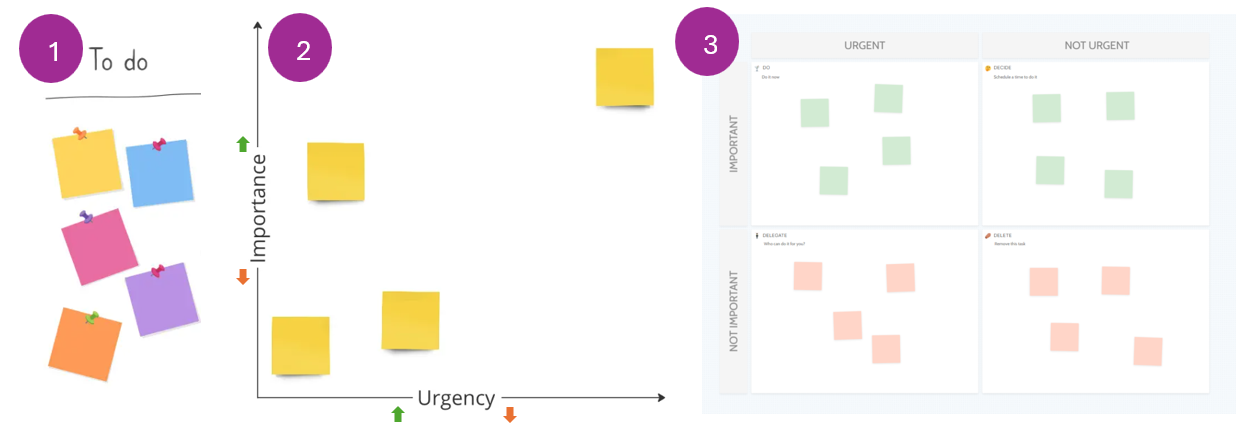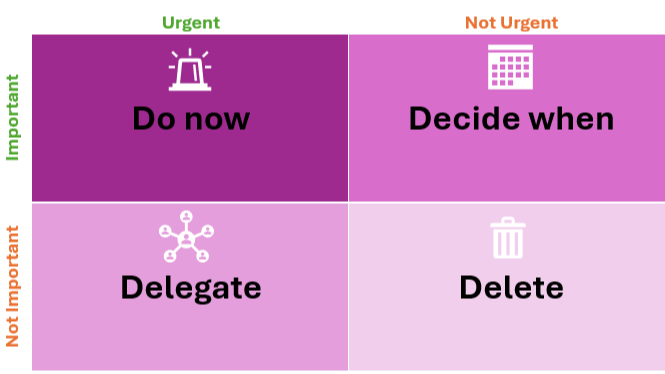Using the Eisenhower Matrix for Productivity and Peace of Mind
Ever feel like you’re juggling endless tasks and can’t figure out which ones to tackle first? Between emails, meetings, deadlines, and everything in between, it’s easy to get overwhelmed. But not every task holds equal weight, and recognizing this can be the key to working smarter, not harder.
Enter the Eisenhower Matrix, a simple yet powerful tool for prioritizing tasks based on urgency and importance.
The concept, inspired by President Dwight D. Eisenhower, helps you sort your tasks into four categories.
Exercise
This exercise helps you visualize where your time is going and ensures you’re focusing on what truly matters.
1. List all your tasks: Write down everything you need to do, big or small.
2. Rank each task by importance and urgency. Compared to task next to it, is it more or less important/urgent? Something has to be the top, and something has to be the bottom.
- Importance refers to how critical the task is to achieving your goals or long-term success.
- Urgency refers to how time-sensitive a task is. Does it need to be done immediately?
3. Divide your rankings into quadrants to place each task into one of the four categories of the Eisenhower Matrix.
This can be done on sticky notes to help you move them around and rank your tasks, or with just some paper (or in a spreadsheet), you can use columns with numbers to rank your items. In both cases, you can then then transfer them into the Matrix.

Then what? Once all of your tasks are sorted into the matrix of important and urgent, Eisenhower’s method then suggests what to do with those in each quadrant.
1. Urgent & Important (Do It Now)
Top left
These tasks demand immediate attention and are critical to your goals. Delaying them could lead to negative consequences. Examples include fixing a critical bug, meeting a project deadline, or responding to an urgent client issue.
Tip: Handle these tasks right away to reduce anxiety. Procrastinating here leads to unnecessary stress.
2. Not Urgent & Important (Decide When / Schedule It)
Top right
These tasks matter but don’t require immediate action. Examples include strategic planning, professional development, or preparing for an upcoming presentation.
Tip: Schedule these on your calendar and protect this time. Investing in these tasks prevents future crises and supports long-term success.
3. Urgent & Not Important (Delegate It)
Bottom Left
These tasks are time-sensitive but don’t necessarily require you to do them. Think of routine emails, status updates, or administrative tasks.
Tip: Regardless of your role, professional or personal, ask yourself if it’s possible that someone else could complete these tasks? Delegate these to team members (or your spouse) or automate where you can. Freeing yourself from these tasks allows you to focus on what truly matters.
4. Not Urgent & Not Important (Delete It)
Bottom Right
If it’s not urgent, and it’s not important. Why are you doing it? These tasks are distractions that don’t contribute to your goals. Examples include gold plating or improving upon something that’s already good enough, unnecessary meetings, or low-value tasks that drain your time.
Tip: Give yourself permission to eliminate these. Cutting them out is liberating and allows you to focus on what’s meaningful. you’ll be surprised how many of these tasks you can just eradicate with little to no negative impact.
Practical Example: How the Eisenhower Matrix Reduces Stress
Let’s say you’re in the middle of a busy workweek. Your to-do list looks like this:
- Prepare for an important client presentation a week away (Not Urgent & Important)
- Respond to an angry client email (Urgent & Important)
- Sent the weekly ‘all good’ report status update (Urgent & Not Important)
- Attend a ‘catch up’ meeting that has no clear agenda or value to your role (Not Urgent & Not Important)
Using the Eisenhower Matrix, you quickly decide:
- Do Now: Respond to the angry client email (Urgent & Important).
- Schedule: Block time tomorrow to prepare for the client presentation (Not Urgent & Important).
- Delegate: Ask a colleague to handle the routine status email (or automate it’s generation) (Urgent & Not Important).
- Delete: Decline the catch up meeting invite (Not Urgent & Not Important).
This clarity reduces overwhelm because you know what needs immediate attention, what can wait, and what you can let go of. Instead of reacting to everything at once, you’re in control.
Why It Works
The Eisenhower Matrix helps you:
- Focus on what matters: Prioritizing important tasks prevents last-minute scrambles.
- Avoid burnout: Delegating and eliminating tasks reduces your workload.
- Stay calm and in control: Knowing what to tackle next eliminates decision fatigue.
Less stress, more productivity.
Your Turn: How do you manage task overload? Have you tried the Eisenhower Matrix? Share your thoughts or strategies below!


Leave a Reply